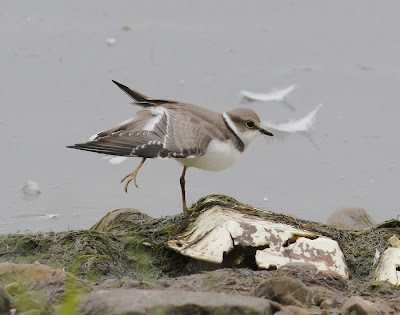I returned to Conder Green today where I found much the same species but with a little variation to recent counts.
For a week or more I suspected there might be more than one Spotted Redshank, confirming it today with one in the main channel and a second one in the channel nearest to the Stork. More Snipe today, with a count of 18 a possible underestimate, plus 5 Greenshank when a flight of three arrived from the west calling loudly to join the two already counted. Still 2 Common Sandpiper around plus the regular 50+ Redshank and 300+ Lapwings roosting in the creeks and on the secluded margins and islands of the pool.
Wildfowl numbers remain similar with 10 Teal, 6 Wigeon and 3 Little Grebe. Three Pied Wagtail around the water margins, a couple of “tacking” Whitethroats, a “ticking” Robin and handfuls of both Goldfinches and Linnets proved to be the only passerines. A single Raven was an early fly over.
Little Grebe
Pied Wagtail
Recent high tides and the resulting water inflow seem to have increased aquatic life/tiny fish stocks in the pool, as suggested by the appearance of more Cormorants, the grebes hanging around the inflow and the regularity of the Kingfisher. There were two Kingfishers this morning, the birds travelling together across the pool and then back towards the creek and the road bridge, their regular spot.
Kingfisher
This morning I watched as a flight of 9 Cormorants came from the direction of the Lune, twisting and turning, whiffling down to the pool, looking for all the world like a gaggle of geese landing on a winter’s day. They then proceeded to fish the water as a pack, their black bodies disappearing below the surface before one by one they resurfaced briefly before dropping below again. After a while the Cormorants flew back out to the Lune, singly or in twos or threes.
Cormorants
Cormorant
The Cormorant is another bird which is very good at catching fish but which is not as popular as the Kingfisher or the supreme angler the Osprey. Unfortunately, unlike that of the Kingfisher and Osprey, the fishing prowess of the Cormorant is not universally admired, anglers in particular being jealous of the Cormorant's expertise.
Most people are familiar with Cormorant fishing, an age-old art practiced in China, Japan, and a few other countries, which today exists largely due to the tourism industry. It is not so generally known that a similar method was once practiced in England.
The ornithologist Francis Willughby (1635-1672), quoting Faber’s Annotations of Rechuss says ‘It is the custom in England to train Cormorants to catch fish. While conveying the birds to the fishing grounds the fishermen keep the heads and eyes of the birds covered to prevent them from being alarmed. When they have reached the rivers, they take off the hoods and having first tied a leather strap loosely around the lower part of the neck that the bird will be unable to swallow down what fishes they catch, throw them into the water. They immediately set to work and pursue the fish beneath them with marvellous rapidity. When they have caught one they rise to the surface, and having first pinched it with their beaks, swallow it as far as the strap permits, and renew the chase until they have caught from five to six each. On being called to their master’s fist, they obey with alacrity and bring up one by one the fish they have swallowed, injured no farther than that they are slightly crushed. The fishing brought to an end, the birds are removed from the neighbourhood of the water, the strap is untied and a few of the captured fish thrown to them as their share of the booty are dextrously caught before they touch the ground.”
Cormorant
More unlikely tales soon from Another Bird Blog.

















































































